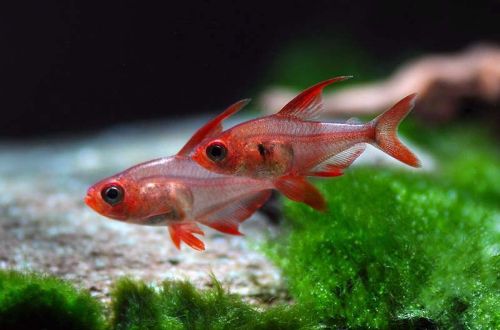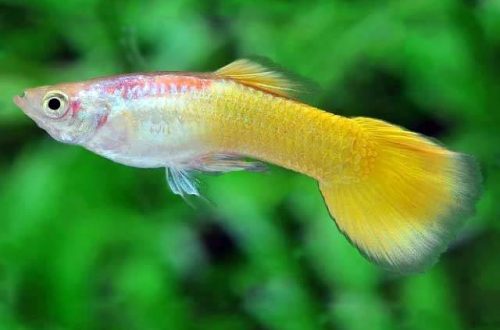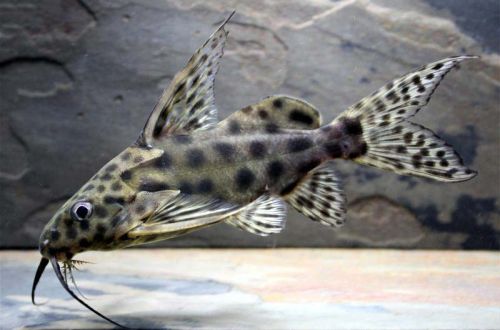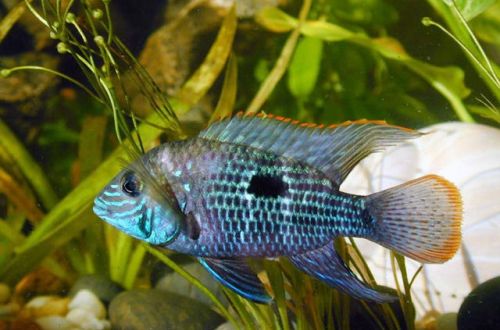
Phantom red
Ornatus red or Phantom red, scientific name Hyphessobrycon sweglesi, belongs to the Characidae family (Characinaceae). A popular beautiful fish, distinguished by its bright coloration and peaceful disposition. Easy to keep and breed, it will brighten up almost any tropical freshwater aquarium if other fish allow it. Due to the very modest size, you should carefully consider the selection of neighbors.

Contents
Habitat
Endemic to the upper basin of the Orinoco River (South America), found in its many tributaries on the territory of the modern states of Colombia and Venezuela. It lives in small rivers and streams, in the canopy of flooded areas of the tropical forest, temporary lakes, as well as in the channels of the main rivers.
Brief information:
- The volume of the aquarium – from 80 liters.
- Temperature – 20-24°C
- Value pH — 4.5–7.5
- Water hardness – mostly soft (1-12 dGH)
- Substrate type – any sandy
- Lighting – subdued
- Brackish water – no
- Water movement – moderate or weak
- The size of the fish is about 3.5 cm.
- Food – any food
- Temperament – peaceful
- Keeping in a flock of at least 8-10 individuals
Description
A small fish, adults reach a length of only 3 cm. They have a rich red body color, the intensity of which, however, depends on the conditions of detention. An aquarium close to its natural habitat will allow you to show all the brightness of colors.
Sexual dimorphism is weakly expressed, males differ only in enlarged dorsal and anal fins, and in females, the tip of the dorsal fin is often white.
Food
Accept all kinds of dry, frozen or fresh food of suitable size. The quality and variety of food also directly affects the color of the fish, so it is recommended to include, for example, small crustaceans (daphnia, brine shrimp) and/or bloodworms in the daily menu.
Maintenance and care, arrangement of the aquarium
Comfortable conditions are achieved in a tank from 80 liters, in the design of which a sandy substrate is used with a certain amount of snags and dense thickets of plants located in groups along the side or back walls of the aquarium. The addition of dried fallen leaves will give a natural appearance and serve as a source of tannins, which are present in large quantities in Red Phantom habitats.
It is worth remembering that before placing the fallen leaves in the aquarium, they are pre-soaked in water for about a week so that they are saturated and begin to sink.
During maintenance, pay special attention to water quality, prevent the accumulation of organic waste, regularly replace part of the water with fresh water, and ensure that pH and dGH are within acceptable limits and the temperature does not exceed 23-24°C.
Behavior and Compatibility
Peaceful schooling fish, content in a group of at least 8-10 individuals. Intraspecific relationships are hierarchical and are built on competition between males for the attention of females. Competition is manifested in the desire to look better brighter than a competitor, and not in fights, like some fish. Compatible with most other peaceful species of similar size and temperament.
Breeding / breeding
They belong to spawning species, females spawn in open water, and males at this moment fertilize it. Parental instincts are not developed, so immediately after spawning, the fish can eat their future offspring.
Easy to breed, fry can appear in the general aquarium, but the survival rate will be at an extremely low level. If you plan to start breeding the Red Phantom, it is recommended to purchase a separate tank of about 20 liters, where spawning will take place.
The spawning aquarium is filled with water from the main tank, a heater and a simple foam airlift filter are used from the equipment. Separate lighting is not required, the light coming from the room is enough. Usually nothing is used in the design. In order to protect the caviar from being eaten, the bottom is covered with a layer of glass beads or a fine mesh is placed.
Mating season can begin at any time throughout the year, but it has been noted that a neutral pH at around 24°C can be stimulated, with a daily diet consisting predominantly of live foods.
When the females are noticeably rounded, they are placed in the company of several of the brightest males in a spawning aquarium. At the end of the action, and this may not happen immediately, but after a few days, the fish are returned back. Feed the fry with specialized food for juvenile aquarium fish.
Fish diseases
A balanced aquarium system with the right conditions is the best guarantee against any disease in the Red Phantom. Therefore, if the behavior of the fish has changed, the color has changed, non-characteristic spots have appeared, and so on, first check the water parameters, and only then proceed to treatment.





